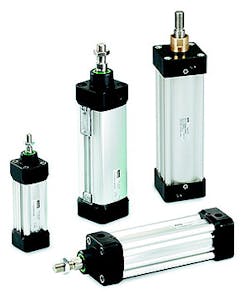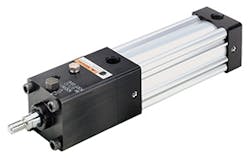Machine operators and construction workers always seem to make it into the Top 10 of the Bureau of Labor Statistics’ (BLS) National Census of Fatal Occupational Injuries. OSHA estimates that workplace injuries, illnesses and deaths cost U.S. employers $170 billion annually.
BLS further notes that many fatalities result from contact with objects and equipment. One cost-effective approach to fighting these numbers, especially where pneumatic controls are in place, is to use rod lock cylinders. These are piston-operated clamps that hold a load in position during emergency-stop (E-Stop) conditions or when an air supply might be accidentally disconnected from a system. In an E-Stop condition, all outputs go dead, and the spring-activated rod lock becomes one of the few functioning components on the machine.
Clamping, holding and ergonomics — Clamping functions are used in machine fixture and conveyor pallet applications. Rod lock cylinders serve as a toggle clamp mechanism in automated assembly lines. In one case, a conveyed pallet is automatically shuttled to each station along an assembly line. Once in position at each station, the cylinder actuates a toggle mechanism to clamp the pallet. Then, air pressure is removed from the cylinder and the rod lock. The pallet fixture is held in place by the rod lock for the machining operation.
Often, rod lock cylinders are used in welding systems. For example, a process for welding heavy structural steel I-beams with common lengths longer than eight feet originally included manual clamping and centering operations. Now, using 100-mm bore P1D rod lock cylinders, the fabricator has automated the process, reducing cycle times and improving safety.
First, I-beams are automatically pushed and held in position with air cylinders. Next, they are clamped at several different points along the I-beam by pairs of rod lock cylinders. Because welding in this application produces thermal deformation of the I-beams, which results in beam movement and poor weld quality, a consistent and high clamping force is necessary.
To accommodate this factor, air pressure is removed from the cylinder and rod lock, engaging the mechanical rod lock and keeping the I-beams exactly in place without any potential rod movement from air compressibility issues. After these steps are complete, using a few hand-operated air valves, welding operations can proceed.
In precision static load-holding instances, a rod lock cylinder serves as a necessary preventive measure to ensure worker safety during manufacturing. These instances include press applications to hold platen or tooling—applications in which vertical loads must remain stationary for extended periods of time, where “zero potential energy” is required (i.e., no pilot-operated check valves are allowed to trap air pressure in the cylinder), or applications where position must be maintained within 0.002 in. for extremely low backlash.
Ergonomic tooling uses cylinders as a mechanical safety measure to balance overhead tooling loads. These applications typically involve heavy or odd-shaped loads that require a manipulator to assist operators in handling the load. If air pressure is lost anywhere within the system, loads could easily fall and potentially harm workers.
In most cases, the manufacturer must take extra steps to ensure that if an E-Stop condition occurs, an external safety device is used. Incorporating this safety functionality into the rod lock cylinder simplifies the design and reduces the number of components in the system.
Rod locks provide a mechanical locking system that can hold loads indefinitely. Air, on the other hand, will eventually bleed through any seals. In the absence of an appropriate air signal, full holding force is applied to the piston rod. When a minimum of 60 PSIG air signal is present, the locking device is released. Thus, rod lock cylinders provide precise load holding capacity with virtually zero backlash and feature high accuracy for demanding, hazardous applications.
Two-Way Load Holding Capability
Equipment faults like sticky valves, hose failures, stored energy, or blocked flow paths can lead to machine tool failure and danger. Rod lock cylinders can hold loads in place and prevent tooling from being dropped or damaged. They provide load-holding capacity in both directions, regardless of stroke position. Air cylinders have different capacities to move a load that corresponds to the position of the piston rod. The output force of the actuator is higher when extending. Therefore, with a pilot-operated check valve, the loading condition changes depending on the direction of motion within the cylinder. Using a rod lock can ensure that load-holding capacity remains constant, regardless of motion direction.
Some facility managers prefer their own or OEM-customized safety device systems. For example, in one case a three-position directional air valve with a “closed center” position locks the current air pressure into both sides of the cylinder. This fails to eliminate rod and machine movement from inertia, external forces and air compressibility issues. Another example relies on an additional cylinder to side-load the rod with friction material or to counteract/ follow the primary cylinder’s stroke.
Some special systems use single-acting cylinders to engage a pin into cross-drilled holes in the primary cylinder’s piston rod, but there can still be significant movement, with the resulting shock load shearing this pin and dislocating the part or other machine members.
Also seen are mating gear racks forced apart by a secondary single-acting cylinder and, when air pressure is below a certain level, the racks are mated to hold the load mechanically. There are mechanical blocking methods that act as a hard-stop for machine movement but they may not be effective enough to guarantee safety.
Most of these safety measures, however, have never been laboratory tested and often are implemented as a quick fix: once installed, they may not be as safe as initially believed. In addition, specialized customer safety devices and systems require intensive OEM interface, testing, and final acceptance evaluation. As an alternative, safety devices can be bundled into commercially available cylinders.
Existing systems can also be retrofitted with rod lock cylinders in two major ways.
First, because the rod lock version of a cylinder is always longer than the base cylinder model, it will properly “drop-in” with the base cylinder only if it was originally mounted at the head end (rod end) of the cylinder. Common mounts that facilitate this “drop-in” interchange include NFPA MF1 (Head Rectangular Flange) and MX3 (Tie Rods Extended Head End) mounts. Other mounts may require a minor fixturing change. In another method, if the original cylinder is of a single-rod design, and the rod end dimensions and location are fixed to the application, the cap end can be converted into a double-rod cylinder with the rod lock on this new or secondary head end.
Power, precision, performance — National Fluid Power Association (NFPA)-rated rod lock cylinders offer bolt-on modularity, enabling one cylinder or lock to be removed or replaced without changing the entire unit. The rod lock may be removed without affecting the base cylinder. Modular construction is important for customized installations or for cylinder servicing.
Rod lock cylinders are available in standard rod diameters as well as oversized versions, depending on the application. This allows for improved column strength when required and permits using a smaller package size rather than selecting a larger bore sized unit due to larger rod or rod-end thread requirements.
A manual override shaft provides rod lock release when equipment is in non-production mode. During installation or maintenance, this means the cylinder can spring back into lock mode automatically when a tool, such as a wrench, is removed from the shaft.
Leading rod lock cylinders include guide units for both NFPA and ISO (International Standard Organization) packages to provide off the shelf stock availability, easier customer installation, significant side load capability, as well as pick-and-place applicability where precise load positioning and holding capacity are required.
Comprehensive safety equipment components must be integrated into overall systems across the board in manufacturing processes to maintain uninterrupted equipment functionality, avoid failure and resulting downtime, and to ensure continued productivity, quality and safety of the workforce. Rod lock cylinders can be a cost-effective solution where pneumatics are concerned.
Clint Trenor is product sales manager for Parker Hannifin. Contact him by email, or visit www.parker.com/pneu/4MA, www.parker.com/pneu/P1D, or www.parker.com/pneu/P5T for more information.


